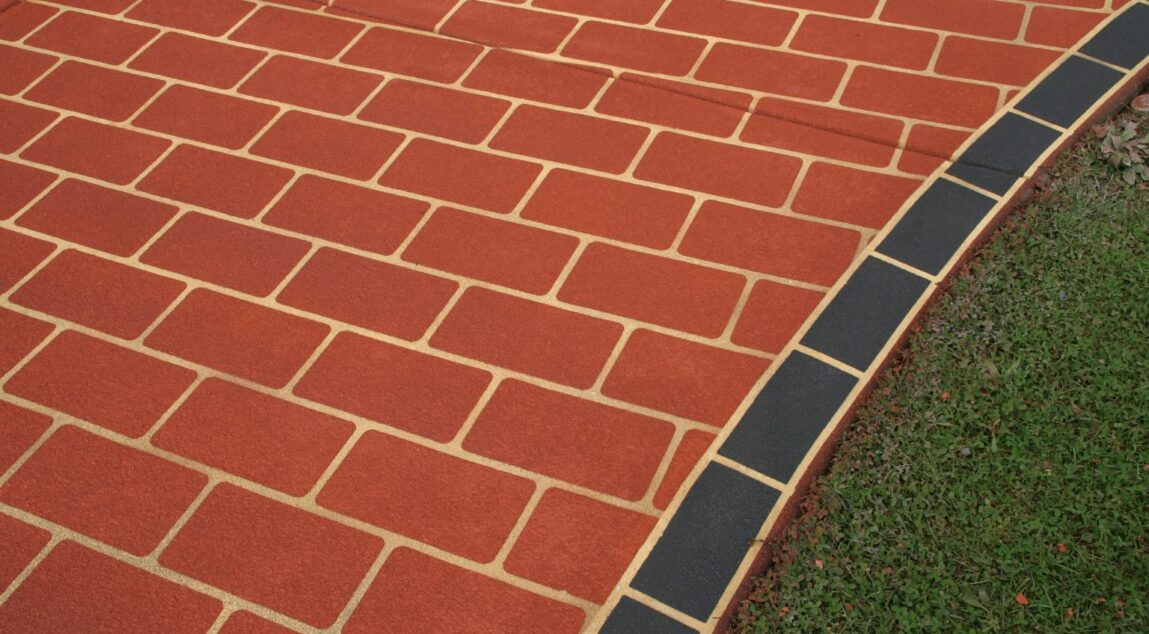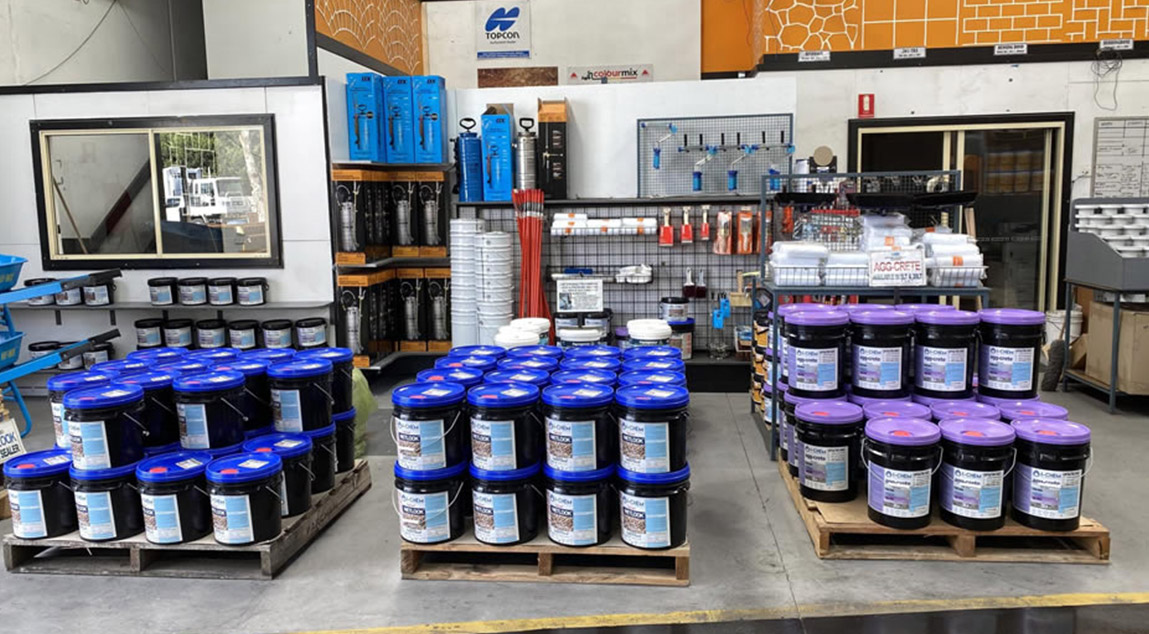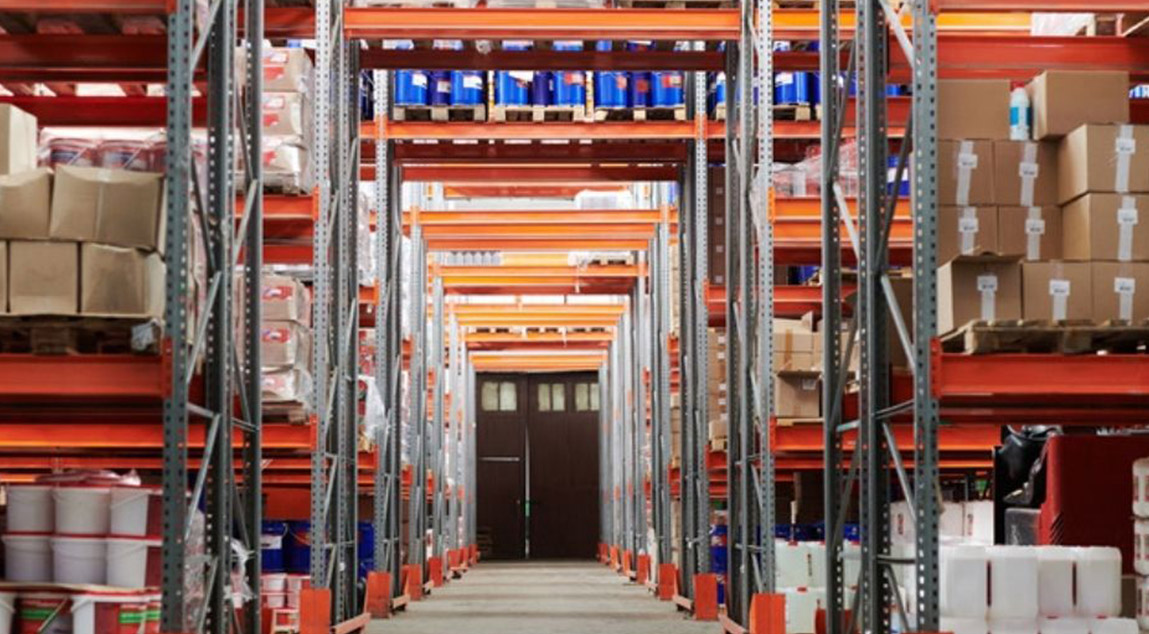A Comprehensive Guide to Concrete Hardeners

Concrete is a robust and reliable construction material, but its porous nature can lead to issues such as moisture absorption and surface wear over time. To combat these issues, concrete hardeners are a great option.
Incredibly durable, easy to apply and available in a range of colours, concrete surface hardener is an excellent way to keep your driveway, parking lots, pathways or other concrete flooring looking and functioning their best. In this article, we discuss what concrete hardeners are, how they work and their benefits.
What Are Concrete Hardeners?
Concrete hardeners are specialised chemical solutions applied to untreated concrete surfaces to increase their hardness and decrease their porosity. When a concrete hardener is applied to the concrete slab, it reacts with the calcium hydroxide in the concrete to form a new compound known as calcium silicate hydrate. This compound forms a tight, crystalline structure within the concrete, reducing its porosity and increasing its strength.
This structural change is integral in reducing what’s known as ‘water ingress’ – a detrimental process where water seeps into the concrete, leading to issues like mould, mildew, and structural instability. By reducing water ingress, concrete hardeners contribute significantly to the longevity and durability of the concrete, making it more resistant to weathering, wear and tear.
But it’s not just about making the concrete harder. Concrete surface hardeners also contribute to the aesthetic appeal of your surfaces. As we’ll cover in a later section on coloured concrete hardeners, these solutions can be mixed with pigments to produce a variety of colourful and visually appealing designs.
The Advantages of Concrete Hardeners
The most prominent benefit of using concrete hardeners is the dramatic increase in the abrasion resistance and durability of the concrete. The hardened surface, with its crystalline structure, is highly resistant to scratches, scrapes and impact damage. Imagine a bustling commercial space with high foot traffic or a driveway where heavy vehicles are regularly parked – concrete hardener adds an additional layer of strength to these surfaces, ensuring they can withstand the wear and tear of daily use without showing signs of damage or deterioration.
Not only do concrete hardeners strengthen the concrete, but they also speed up the curing process. For those unfamiliar with the term, ‘curing’ refers to the time it takes for a concrete slab to harden and reach its full strength. With the introduction of concrete hardeners, this timeline is significantly shortened. This is a boon for project managers and contractors, as it allows for quicker project completion, improving efficiency and reducing labour costs.
Moreover, incorporating a concrete strengthener into the mix enhances these benefits. By reinforcing the concrete at a molecular level, these additives further enhance its resistance to abrasion and impact, prolonging its lifespan even in demanding environments.
Beyond the practical benefits, concrete surface hardeners are also more environmentally sustainable. By increasing the lifespan of concrete surfaces and reducing their maintenance needs, the demand for concrete replacement or repair is significantly diminished. This translates to fewer resources consumed and less waste generated, contributing to a more sustainable home or business. Furthermore, concrete hardeners are low in volatile organic compounds (VOCs), meaning they have a minimal impact on air quality.This makes them a more eco-friendly choice when compared to some other concrete treating methods.
How to Apply Concrete Hardeners
Using concrete surface hardeners is not as complex as it may initially seem. The process can be divided into two primary sections, depending on the type of hardener used: integral hardeners and surface hardeners.
Integral hardeners are mixed directly into the concrete mixture before it is poured. This process ensures that the hardening properties are distributed evenly throughout the concrete, enhancing its overall strength and durability. However, it’s crucial to get the ratio of concrete to hardener right, as too much or too little hardener can adversely affect the concrete’s final curing and hardness. A general guideline is to use 20 kilograms of hardener for every 10 m² of surface area.
On the other hand, surface hardeners are applied to the concrete after it has set. This process involves cleaning and drying the concrete surface thoroughly before applying the hardener. The application must be done evenly, allowing the hardener to penetrate the concrete’s porous surface. It typically takes around 20-30 minutes for the hardener to seep into the concrete. At this point, any excess hardener should be removed with a squeegee or broom to prevent uneven hardening.
When handling concrete hardeners, whether integrated or surface, safety should always be a priority. These substances, while beneficial to concrete, can cause skin and eye irritation. Therefore, protective clothing, including gloves and eyewear, should be worn during the application process.
Coloured Concrete Hardeners
Coloured concrete hardeners, a recent development in the field of concrete hardening, are truly a game-changer. They have all the functional properties of traditional concrete hardeners while adding an aesthetic dimension with their vibrant pigments. This combination of durability and design has opened up a plethora of creative opportunities in the realm of concrete projects.
The primary role of coloured concrete hardeners remains the same as their regular counterparts – to enhance the hardness and reduce the porosity of the concrete surface.
However, what sets coloured concrete hardeners apart are the incorporated pigments. These pigments permeate the concrete surface, providing it with a rich, long-lasting colour. This feature makes coloured concrete hardeners particularly suited for decorative concrete projects such as patios, driveways, and walkways, where aesthetics play a key role alongside functionality.
If you’re looking to take your project up a notch, consider combining hardener with stencils to create brick, stone or rosette patterns. You can turn your driveway or patio into a work of art that will last for years to come!
In terms of selection tips, it’s important to consider the environment where the concrete will be laid. Choose a colour that complements the surrounding area and the architectural style of any adjacent buildings. Furthermore, consider the traffic the area will receive. Darker colours might be more suitable for high-traffic areas as they can better hide dirt and stains.

Frequently Asked Questions
Concrete hardeners come in two primary variations: surface hardeners and integral hardeners. Surface hardeners are a post-treatment option that’s applied to the concrete after it has set. This method is beneficial when you want to enhance the durability of an existing concrete surface. On the other hand, integral hardeners are mixed into the concrete before it is poured. This pre-treatment method is a proactive approach to creating a more durable concrete from the get-go.
Both types of concrete hardeners chemically interact with the concrete to improve its hardness, but their application and usage can vary depending on the needs of the project. It’s essential to choose the right type of hardener based on specific project requirements and durability expectations. If you’re not sure what hardener type you need, contact the professionals at Australian Slate-Crete Supplies.
The ratio of concrete to hardener varies depending on the type of hardener and the specific requirements of your project. However, as a general rule, you can use 20 kilograms of hardener for every 10 m² of concrete with Australian Slate-Crete Supplies’ hardener. Always follow the manufacturer’s instructions to achieve the best results. Remember, using the correct ratio is crucial for ensuring increased durability and reduced porosity.
While concrete hardeners and sealers may seem similar, they serve different purposes and function in distinct ways. Concrete hardeners work by penetrating the concrete and reacting chemically with it to increase its hardness and reduce its porosity. This process strengthens the concrete itself, increasing its resistance to wear and tear.
In contrast, concrete sealers form a protective layer on the surface of the concrete, acting as a barrier against moisture penetration and other environmental factors. Sealers primarily focus on protecting the surface of the concrete while hardeners enhance the concrete’s inherent properties.
Understanding these differences is critical to making an informed decision about what’s best for your concrete project. Whether you’re working on residential spaces, a commercial building, or a decorative concrete installation, the choice between a hardener or sealer will greatly impact the durability, appearance, and longevity of your concrete surfaces.
Buy Concrete Hardener Products in Melbourne
Concrete hardeners are not just an add-on but an essential tool in any good concrete-related project. They offer a practical solution to the potential weaknesses of concrete, enhancing its durability and reducing its curing time. The world of coloured concrete hardeners even opens up the possibility of adding aesthetic appeal to the functionality, offering innovative design possibilities in combination with stencils. As the construction industry evolves, the use of concrete hardeners is set to become even more prevalent, offering a robust and sustainable solution to age-old challenges.
If you’re looking to find out more about concrete hardeners or want recommendations for your next DIY project, Australian Slate-Crete Supplies is the team you need. Our decades of experience and specialised, highly tested product range means you’ll never need to go anywhere else for your concreting supplies in Melbourne.
Ready to make your concrete flooring or surface more durable and beautiful? Get in touch with us on 03 9408 7722 for a friendly chat.
-
 February 4, 2022Sandstone Concrete Stencil
February 4, 2022Sandstone Concrete StencilDo you want to add a touch of luxury and elegance to your concrete projects? If so, then consider using sandstone concrete stencils!
Read More -
 February 4, 2022Gloss Brick Sealer
February 4, 2022Gloss Brick SealerGloss brick sealer is a wonderful material for adding a brilliant shine to your brick slip wall feature.
Read More -
 February 4, 2022Bluestone Concrete Sealer
February 4, 2022Bluestone Concrete SealerIn a broad sense, the term “bluestone” is sometimes used to refer to a variety of stones. It’s a marketing term rather than a geological one.
Read More
